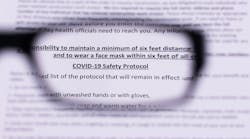One day after he was inaugurated, President Joe Biden fulfilled a campaign promise to labor unions by ordering the Occupational Safety and Health Administration (OSHA) to begin the process of developing COVID-19 Emergency Temporary Standards (ETS) for employers.
Both OSHA and the Mine Safety and Health Administration (MSHA)—sister agencies operating under the aegis of the Department of Labor (DOL)—were directed to come up with new enforcement guidances within two weeks after the order was signed.
However, OSHA also was directed to consider developing ETS, which possess the status of formal regulations unlike guidances, the order specifically mentioning the prospect of requiring masks in the workplace. However, the agency won’t have very long to mull the possible content of potential ETS because whatever OSHA develops along these lines must be issued by March 15, according to the order.
Of course, OSHA has been issuing guidances for employers on how to deal with the COVID-19 pandemic since early last year, initially incorporating advice from the Centers of Disease Control and Prevention (CDC) and other sources. Nonetheless, unions have argued that the previous guidances lacked the force and power of ETS regulations, which they demanded be developed.
Under the Trump administration, OSHA did pursue enforcement actions against employers—primarily in the healthcare industry—for failing to take adequate measures to protect their employees. Along the way, OSHA and other federal agencies were forced to revise and alter their guidances to deal with changing circumstances and requests for clarification from employers and the public. It is unclear whether a formal federal ETS could be amended as quickly and easily.
If OSHA chooses to issue ETS—something that it is generally expected to do—the standards would take effect immediately and last no longer than six months, unless they are eventually adopted as a permanent standard, notes attorney Robert J. O’Hara of the law firm of Epstein Becker & Green.
States Could Be Models
Some states with their own occupational safety programs have adopted their ETS. These standards developed by Michigan, Virginia, California, Oregon and Washington State could end up serving as models for the federal ETS. In the cases of California and Virginia, the ETS rules are lengthy and extraordinarily detailed and have attracted opposition because they are seen as burdensome for small business employers.
California’s ETS is long, detailed and imposes numerous obligations on employers. It has drawn a lawsuit filed by several small businesses in the state, the National Retail Federation and the National Federation of Independent Business. Virginia’s ETS rules are in the process of being made permanent but also have drawn a lawsuit from the Virginia Manufacturers’ Association and several individual employers.
The Jan. 21 presidential order instructs OSHA to ensure that workers currently covered by the nation’s 22 state OSH plans are adequately protected from COVID-19, consistent with OSHA’s revised guidance or ETS, which will be applicable in the remaining states.
The order also is notable because it has explicitly carved out a formal role for unions in some circumstances. For example, OSHA was instructed to consult with state and local government entities that have responsibility for public employee safety and health, and work with public employee unions to bolster protection from COVID-19 for public sector workers.
The order also directs the secretaries of Agriculture, Labor, Health and Human Services, Transportation, and Energy to take COVID-19 worker safety protection measures by working in conjunction with other federal agencies, although there are no other details provided for how they are expected to accomplish this.
“The federal government must take swift action to reduce the risk that workers may contract COVID-19 in the workplace,” President Biden’s order states. “Healthcare workers and other essential workers, many of whom are people of color and immigrants, have put their lives on the line during the coronavirus pandemic. It is the policy of my Administration to protect the health and safety of workers from COVID-19.”
OSHA is directed to launch a national program to focus enforcement efforts related to COVID-19 on targeting violations that put the largest number of workers at serious risk or are contrary to anti-retaliation principles. The order’s reference to vulnerable minorities extends to a mandated review of OSHA’s enforcement efforts related to COVID-19. The review is aimed at identifying any short-, medium- and long-term changes that could be made to not only better protect workers, but also to “ensure equity in enforcement.”
DOL’s Office of Public Affairs and Office of Public Engagement and all regional OSHA offices are ordered by the President to conduct a multilingual outreach campaign to inform workers and their representatives of their rights under applicable law. “This campaign shall include engagement with labor unions, community organizations and industries, and place a special emphasis on communities hit hardest by the pandemic,” the order declares.
For its part, MSHA is directed to consider whether any emergency temporary standards regarding COVID-19 applicable to coal and metal or non-metal mines are necessary and consistent with applicable law, and if so, issue ETS for the mining industry as soon as practicable.

